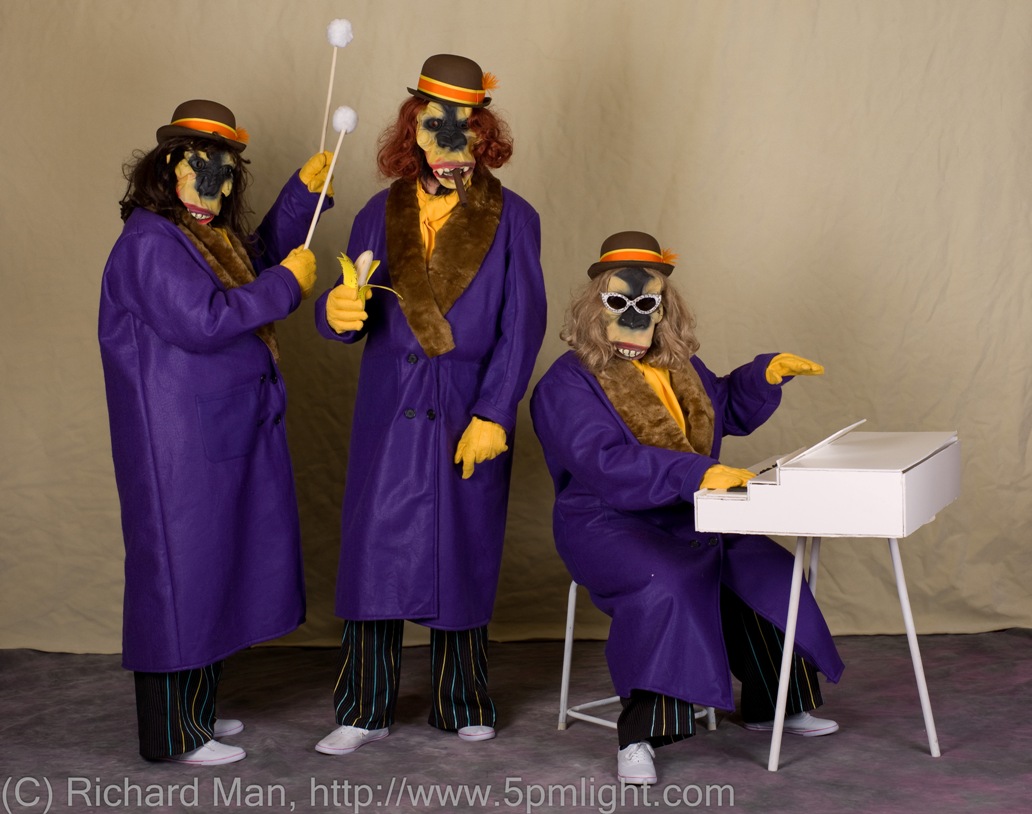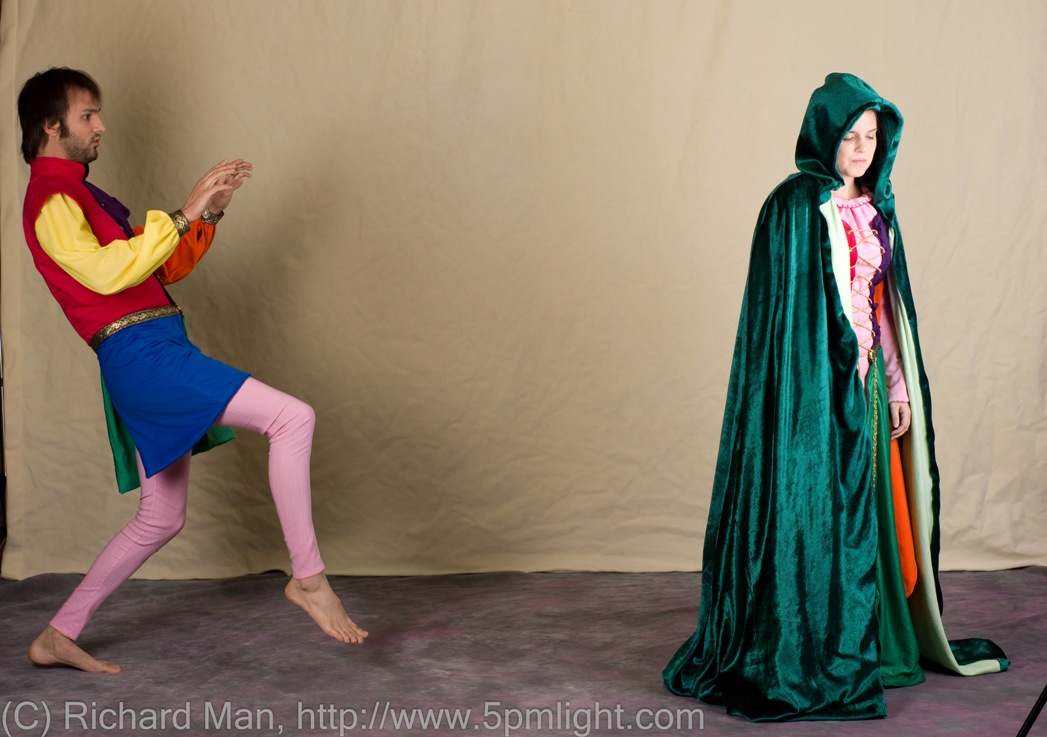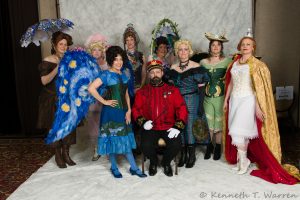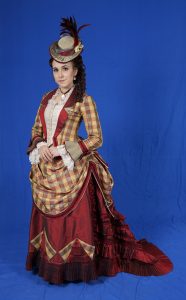CC28-H-12a: Jesterly Spies
CC28-H-12a: Jesterly Spies | Division: Novice | Category: Hist. Interpretation | Designer(s): Michael Ritchie and Valerie Ritchie | Maker(s): Michael Ritchie and Valerie Ritchie | Presenter(s): Michael Ritchie and Valerie Ritchie | Presentation Award(s): Recognition for Physical Comedy (Photo ID: Richard Man | Event Date: 2010)
Competition Staff & Rules
Staff:
- Directors: Pierre E. Pettinger Jr. and Sandy Pettinger
- Master of Ceremonies: Steve Swope
- Presentation Judges: Carol Inkpen, Dawn McKechnie and Karen Schnaubelt
Rules:
Costume-Con 28 Historic Masquerade
The Historic Masquerade is more than just a costume competition. It is an opportunity for research and applied scholarship. It is also recognizes creativity, workmanship and stage presentation. All cultures, locales and historical eras are eligible to compete in the Historical Masquerade.
Like all competitions, this one does have rules. We have attempted to keep them to a minimum; but please review them carefully and follow them.
Rules:
1. The Historic Masquerade will limit entries to time periods up to and including December 31, 1970. The Historic Masquerade will take place on Sunday, May 9, 2010. You must be an attending member of Costume-Con 28 to compete in the Historic Masquerade, as must any models you may use.
2. All entries must register before 6:00 P.M., Friday, May 7, 2010. Documentation is also due by this time. You may pre-register. A form will be available on the convention website closer to the convention weekend. If you pre-register, you must turn in your documentation by the above deadline.
3. The Historic Masquerade will follow the International Costumers’ Guild Guidelines for International Level Masquerades and Competitions.
4. Categories: All categories are eligible for Best in Class and Best in Show. The Historic Masquerade will use the following categories:
- Historic Reproduction: This category is for costumes that are based on a specific, existing costume, painting or illustration. The goal of a Historic Reproduction is to look exactly like the original costume or illustration. (Note exception: If your source is a black and white illustration you may add color appropriate to the time and place of the costume. You can also choose to leave it in a black and white form.)
- Historic Dress: This category is for entries who are attempting to look like they came from the time and place they are creating. These costumes are original in design, but must adhere to period characteristics of fabric, color, fabrication and style.
- Historic Interpretation: This category is for those costumes based on a Historic period and place, but which intentionally, visibly and obviously departs from it. If the judges have to ask you why your costume is an interpretation, it probably belongs in Historic Dress.
- Ethnic Costume: A costume in this category may be from any time period, including the present. (Yes, this is the exception to Rule number 1.)
5. Skill Divisions: The Costume-Con 28 Historic Masquerade will use Skill Divisions to assure fairness to all entrants. We will use the following Skill Divisions:
- Young Fan: This level is limited to entrants 12 years of age or younger. It will be divided between those costumes built by the young fans themselves and those built by an adult that the young fan presents.
- Novice: The Novice level is for beginning costumers. You may not enter in the Novice level if you:
- Have won three awards in the Novice division in a Costume-Con Historic Masquerade;
- Have won any award (including Honorable Mention) while competing in a division higher than Novice in a Costume-Con Historic Masquerade;
- Compete in the Master division in the Fantasy and Science Fiction Masquerade at Costume-Cons or Worldcons (World Science Fiction Convention);
- Possess a Costume Laurel in the Society for Creative Anachronism or a similar accolade in an equivalent organization;
- Are a Professional in the Costuming Field. Professional is defined as someone who earns a majority of his or her income from fashion or costume, including college or university faculty members.
Have won Best in Class in the Novice division or Best in Show at a Costume-Con Historic Masquerade;
- Journeyman: The Journeyman level is an intermediate division for those who are no longer Novices, but are still honing their costuming skills. You may not enter at the Journeyman level if you:
- Have won three awards at the Journeyman level at Costume-Con Historical Masquerades;
- Have won Best in Class in the Journeyman division or Best in Show at a Costume-Con Historic Masquerade;
- Have won an award at the Master level in either a Costume-Con or Worldcon masquerade (either Historical or Fantasy and Science Fiction);
- Possess a Costume Laurel in the Society for Creative Anachronism or a similar accolade in an equivalent organization;
- Are a professional in the Historic costuming field (professional as defined above).
- Master: The Master level is an open level. Anyone may enter and compete at this level if they wish. You must enter at this level if you are not eligible to enter as a Young Fan, Novice or Journeyman. (Note that if you are not required to enter at the Master level and decide to enter at this level and win any award, you must enter at the Master level at all future competitions. If you do not win an award you may enter in your qualifying division at future competitions.)
6. Judging: Our judges will evaluate (and issue awards) in three areas. Entries will be judged against what the judges see as an award-winning standard. The judges reserve the right to not issue awards in any area or to award a Best in Class or Best in Show.
7. Documentation: All entries require documentation. Documentation must be received at the masquerade registration desk no later than 6:00 PM on Friday of the con. If you are arriving at the con later than this, please contact us well in advance. We will make accommodations for reasonable situations. Documentation may not be submitted as computer disks (CD’s or DVD’s), memory sticks or any type of video.
8. Basic Documentation: The basic requirements for all documentation are:
- Title of Costume
- Name and address of the person responsible for the entry (or the spokesman for a group)
- Name(s) of designer(s) and maker(s)
- Brief identifying description of the costume’s historic period, geographic origin, social class and so forth. This description should include the historic basis for the costume. This basis could be as simple as a single photo, but could be more comprehensive. This would also be the be the point to notate any substitutions of historically accurate materials used. Always assume the judges are not familiar with your period. The text portion of basic documentation may not exceed 5 pages. Photos do not have a limit.
- Bibliography of sources. The bibliography may be of any length.
9. Advanced Documentation: Advanced documentation is not to imply that it is better than Basic Documentation. It is intended to allow the contestant more latitude in their documentation. The characteristics of Advanced Documentation are:
- All the requirements of Basic Documentation above.
- Additional text is allowed. This must be clearly separated from the basic text above. The contestant may expound at greater length on the costume’s basis and the choices made. More detailed descriptions of work and technique are also allowed here. Keep in mind that the judges may not have time to read all your text. That is why you must have all the limited basic text noted above.
- Creative and innovative formats. Past entrants have used such things as embellished books, scrolls, maps and even rocks for documentation. Your imagination is the limit.
10. Workmanship: All contestants must take part in Workmanship judging. This is your opportunity to let the judges admire your work up close. Each entry will meet privately with our judges. Entrants will be expected to show the judges all necessary parts of the costume. It is recommended that entrants bring the costume to the judges rather than wear it. This will allow them to more closely examine the costume. If you choose to wear your costume, you must be prepared for the judges (who can be of either gender) to lift your skirts, examine your cleavage and peer at your underpinnings. If you are particularly proud of a particular part of the costume, be sure to bring it to the judge’s attention. Workmanship judging will be limited to 5-10 minutes per person. The exact time will depend on the number of entrants. Entrants will have an opportunity to sign up for workmanship judging appointments when they register or check in at the masquerade desk.
11. Stage Presentation: All entrants must appear on stage. This is your opportunity to show your costume to best effect or tell the story you wish to tell.Entrants with 1-4 persons will be allowed no more than 60 seconds to present your costumes. Entries with more than 4 persons will be allowed up to 90 seconds. You will have to convince us if you wish more time. It will not be an easy job to convince us.
We strongly recommend that all entrants use music to enhance their presentation. See technical requirements for music elsewhere in the Costume-Con 28 rules (forthcoming later in 2009).
Additional Rules
1. All general rules for the Costume-Con 28 stage apply.
2. Individuals may appear in the Historic Masquerade only once. You may enter more than one costume, but it must appear on another body.
3. No purchased or rented costumes may compete. If you have an interesting costume you think the audience might enjoy that is purchased you may show it in Exhibition. Exhibition costumes do not require documentation or workmanship judging.
4. No nudity! This is a PG-13 show.
5. Costumes that have won awards for presentation or workmanship at past Costume-Cons or Worldcons may not appear in competition in Costume-Con 28’s Historic Masquerade. They may appear as Exhibition Costumes.
6. No flame, fire, pyrotechnics or messy substances (such as peanut butter) will be allowed on stage.
7. Drawn weapons must be approved by the Masquerade Directors.
8. Any electrical effects must be self-powered. No power cords will be allowed.
9. No live animals will be permitted. (Guide animals excepted)
10. Children must be kept under the control of a responsible adult at all times.
11. Your costume must be complete when you come to the Green Room. Final assembly of large items is permitted; however the Green Room is for dressing and prepping for stage, not for construction or painting.
12. Follow the technical rules for CD’s or other music media.
13. You must attend a technical rehearsal prior to going on stage. Rehearsal times will be available at registration/check-in. You must come to your rehearsal ready to go and wearing any portion of your costume needed to practice your movements: large feet, hoop skirts and so forth. (You are not required to wear your entire costume to rehearsal.) You may also bring some swatches of fabric so the lighting crew can help you pick lights.
14.Default lighting will be stage dark, rising to full lighting when entry is announced, fading to dark on exit.
15. Default music will be start after entry is announced and faded out at exit.
16. Following your entry’s exit, any props must be removed from the stage.
17. The Green Room is for entrants, roadies and masquerade staff only. Please do not invite family or friends to the Green Room or backstage.
18. All entrants must go through Official Photo. This is not optional. Refusal to be photographed is grounds for elimination from the masquerade.
19. Surprise the audience, but never the Directors, staff or technical crew. Contact us if you are planning something unusual that may violate any of these rules.
20. If you think any of these rules don’t apply to you, you are wrong! Exceptions are possible, but only by approval of the Masquerade and Technical Directors.
21. The Masquerade Directors have full authority to eliminate anyone from the competition on the grounds of bad taste, danger to self or to other, violation of the rules or any other reason deemed sufficient. There is no appeal.
If you have any questions, please contact Pierre and Sandy Pettinger, Costume-Con 28 Historic Masquerade Directors.




